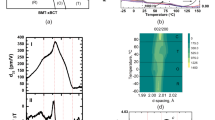Abstract
The macroscopic electromechanical coupling properties of ferroelectric polycrystals are composed of linear and nonlinear contributions. The nonlinear contribution is typically associated with the extrinsic effects related to the creation and motion of domain walls. To quantitatively compare the macroscopic nonlinear properties of a lead zirconate titanate ceramic and the degree of domain orientation, in-situ neutron and high-energy x-ray diffraction experiments are performed and they provide the domain orientation density as a function of the external electric field and mechanical compression. Furthermore, the macroscopic strain under the application of external electrical and mechanical loads is measured and the nonlinear strain is calculated by means of the linear intrinsic piezoelectric effect and the linear intrinsic elasticity. The domain orientation density and the nonlinear strain show the same dependence on the external load. The scaling factor that relates to the two values is constant and is the same for both electrical and mechanical loadings.







Similar content being viewed by others
References
B. Jaffe, W.R. Cook, and H. Jaffe: Piezoelectric Ceramics (Techbooks, Falls Church, VA, 1989).
W.J. Merz: Domain formation and domain-wall motions in ferroelectric BaTiO3 single crystals. Phys. Rev. 95(3), 690 (1954).
B. Lewis: Energy loss processes in ferroelectric ceramics. Proc. Phys. Soc. London 73(469), 17 (1959).
D. Berlincourt and H.H. Krüger: Domain processes in lead titanate zirconate and barium titanate ceramics. J. Appl. Phys. 30(11), 1804 (1959).
A.B. Schäufele and K.H. Härdtl: Ferroelastic properties of lead zirconate titanate ceramics. J. Am. Ceram. Soc. 79(10), 2637 (1996).
J.Y. Li, R.C. Rogan, E. Üstündag, and K. Bhattacharya: Domain switching in polycrystalline ferroelectric ceramics. Nat. Mater. 4(10), 776 (2005).
M.J. Hoffmann, M. Hammer, A. Endriss, and D.C. Lupascu: Correlation between microstructure, strain behavior, and acoustic emission of soft PZT ceramics. Acta Mater. 49(7), 1301 (2001).
C.A. Randall, D.J. Barber, and R.W. Whatmore: Ferroelectric domain configurations in a modified-PZT ceramic. J. Mater. Sci. 22(3), 925 (1987).
S.P. Li, A.S. Bhalla, R.E. Newnham, L.E. Cross, and C.Y. Huang: 90-degrees domain reversal in Pb(ZrXTi1-X)O3 ceramics. J. Mater. Sci. 29(5), 1290 (1994).
R.C. Rogan, E. Üstündag, B. Clausen, and M.R. Daymond: Texture and strain analysis of the ferroelastic behavior of Pb(Zr, Ti)O3 by in situ neutron diffraction. J. Appl. Phys. 93(7), 4104 (2003).
J.L. Jones, M. Hoffman, and S.C. Vogel: Orientation-dependent lattice strains in lead zirconate titanate under mechanical compression by in situ neutron diffraction. Physica B 385, 548 (2006).
J.L. Jones, M. Hoffman, and S.C. Vogel: Ferroelastic domain switching in lead zirconate titanate measured by in situ neutron diffraction. Mech. Mater. 39(4), 283 (2007).
J.L. Jones, A. Pramanick, J.C. Nino, S.M. Motahari, E. Üstündag, M.R. Daymond, and E.C. Oliver: Time-resolved and orientation-dependent electric-field-induced strains in lead zirconate titanate ceramics. Appl. Phys. Lett. 90(17), 172909 (2007).
A. Pramanick, A.D. Prewitt, M.A. Cottrell, W. Lee, A.J. Studer, K. An, C.R. Hubbard, and J.L. Jones: In situ neutron diffraction studies of a commercial, soft lead zirconate titanate ceramic: Response to electric fields and mechanical stress. Appl. Phys. A Mater. Sci. Process. 99, 557 (2010).
K.G. Webber, E. Aulbach, T. Key, M. Marsilius, T. Granzow, and J. Rödel: Temperature-dependent ferroelastic switching of soft lead zirconate titanate. Acta Mater. 57(15), 4614 (2009).
Y. Zhang, D.C. Lupascu, E. Aulbach, I. Baturin, A. Bell, and J. Rödel: Heterogeneity of fatigue in bulk lead zirconate titanate. Acta Mater. 53(8), 2203 (2005).
T. Fett, D. Munz, and G. Thun: Young’s modulus of soft PZT from partial unloading tests. Ferroelectrics 274, 67 (2002).
A. Brule and O. Kirstein: Residual stress diffractometer KOWARI at the p]Australian research reactor OPAL: Status of the project. Physica B 385-386, 1040 (2006).
J.L. Jones, B.J. Iverson, and K.J. Bowman: Texture and anisotropy of polycrystalline piezoelectrics. J. Am. Ceram. Soc. 90(8), 2297 (2007).
J.L. Jones, M. Hoffman, and K.J. Bowman: Saturated domain switching textures and strains in ferroelastic ceramics. J. Appl. Phys. 98(2), 24115 (2005).
J.L. Jones, E.B. Slamovich, and K.J. Bowman: Domain texture distributions in tetragonal lead zirconate titanate by x-ray and neutron diffraction. J. Appl. Phys. 97, 3 (2005).
D.A. Hall, A. Steuwer, B. Cherdhirunkorn, T. Mori, and P.J. Withers: A high energy synchrotron x-ray study of crystallographic texture and lattice strain in soft lead zirconate titanate ceramics. J. Appl. Phys. 96(8), 4245 (2004).
D.A. Hall, A. Steuwer, B. Cherdhirunkorn, P.J. Withers, and T. Mori: Micromechanics of residual stress and texture development due to poling in polycrystalline ferroelectric ceramics. J. Mech. Phys. Solids 53(2), 249 (2005).
R. Guo, L.E. Cross, S.E. Park, B. Noheda, D.E. Cox, and G. Shirane: Origin of the high piezoelectric response in PbZr1-xTixO3. Phys. Rev. Lett. 84(23), 5423 (2000).
Acknowledgments
The authors acknowledge the support for this work from the Deutsche Forschungsgemeinschaft under GR 2722/4-1, the U.S. National Science Foundation under award DMR-0746902, and the U.S. Department of the Army under award W911NF-09-1-0435. The Bragg Institute at the Australian Nuclear Science and Technology Organisation is acknowledged for provision of the neutron diffraction facilities through proposal number 1265. The assistance and cooperation of Dr. Vladmir Luzin at the Bragg Institute is also gratefully acknowledged. We also thank Dr. Doug Robinson at the Advanced Photon Source (APS) for his invaluable assistance in making the beam campaign a success. Use of the APS was supported by the U.S. Department of Energy, Office of Science, Office of Basic Energy Sciences, under contract no. DE-AC02-06CH11357.
Author information
Authors and Affiliations
Corresponding author
Rights and permissions
About this article
Cite this article
Marsilius, M., Granzow, T. & Jones, J.L. Quantitative comparison between the degree of domain orientation and nonlinear properties of a PZT ceramic during electrical and mechanical loading. Journal of Materials Research 26, 1126–1132 (2011). https://doi.org/10.1557/jmr.2011.40
Received:
Accepted:
Published:
Issue Date:
DOI: https://doi.org/10.1557/jmr.2011.40




